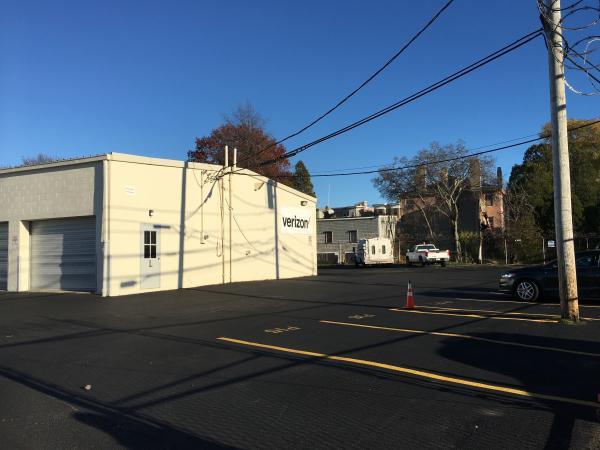December 1, 2016

The Verizon Fios garage shares a boundary with the historic Clapp properties. Jennifer Smith photo
Residents in several of Boston’s historic houses are sounding alarms over new around-the-clock activity at the Verizon Fios facility on Enterprise Street bordering the Dorchester Historical Society (DHS) properties along Boston Street.
Early mitigation efforts have done little to halt the jarring industrial noise, neighbors say; Verizon officials counter that the company will propose sound-dampening measures in the coming weeks.
Peggy Mullen’s bedroom window in the Lemuel Clapp house, where she has lived as a caretaker for more than a quarter-century, sits about 15 yards from the Verizon property line. Over the decades, she says, the next-door garage has had little or no impact on her quality of life – until trouble blew through the house one day in July of this year.
Workers were out blacktopping the parking lot around the Verizon facility and sending asphalt fumes through her open windows. Then came the trucks, and the constant clamor.
“This was not the same as a garage fixing trucks,” Mullen said on Monday as she walked along the chain-link fence that separates the historical society’s property from the phone company’s lot. “They lined up all these trucks along the property line at 5:30 in the morning, slamming doors, dragging out those big reels of fiber optic cable, and making a racket to the point where we couldn’t sleep.”
According to Verizon spokesman Mike Murphy, the garage has served since August as a work location for the construction teams that are building out the $300 million project to wire Boston with Verizon Fios cable. Crews begin and end their shifts at Enterprise Street.
The historical society’s property sits at an intersection between a residential zoning district with a historically significant streetscape and a commercial parcel zoned for repair service/garage use. No substantive buffer against noise exists between the properties.
The Dorchester zoning code requires screening or buffering between commercial/industrial subdistricts and adjacent residential districts, meaning that any new projects that resembled Verizon’s property would be required to install at least a five-foot buffer zone with some sort of densely-packed shrubbery and partly opaque retaining wall or fence.
The city’s Inspectional Services Department (ISD) says the Verizon lot pre-dates the zoning code, which was industrial when it opened for business. ISD Commissioner William Christopher said that, while all operations at the Verizon facility are “perfectly legal,” generally such properties “should have a buffer between the two of them.” But in this case, he added, “they are both pre-existing conditions.”
The Lemuel Clap house was built in the 17th century, and remodeled in 1760. The adjacent William Clapp house, which sits on the 34,659-square-foot parcel containing both colonial houses, a barn, and a carriage house, went up in 1806. The society uses the William Clapp house as its headquarters and each house is occupied by caretakers who provide security and maintenance and conduct monthly tours, said DHS president Earl Taylor.
On a tour of the Lemuel Clap house, Mullen noted a number of recent cracks in the exterior windows. Taylor said that while those involved are “generally concerned whether any damage might occur to our property, we can’t attribute any physical changes to the building to Verizon.” It’s all about the ceaseless noise.
Abutting full-time residents say the clamor at the facility is disturbing them through the evening into the early morning hours before picking up again a few hours later, often before 6 a.m.
“You know, I cannot spend a weekend sitting down to read,” Mullen said. “I can’t spend an evening sitting down to read... I think they don’t belong here.”
Unlike an earlier demolition across Enterprise Street, where an apartment building is being constructed, the Verizon activity does not shake the entire house, Mullen said, but the trucks toting fiber optic cables rattle the windows and send vibrations through the floors. With the colder weather, she added, the trucks sit longer in idling mode, more than the five minutes they are permitted by law.
Mullen points to city noise restrictions that define air pollution as that which does “unreasonably interfere with the comfortable enjoyment of life and property or the conduct of business,” noting that certain decibel limitations apply to residential/industrial areas. “Interfere with the comfortable enjoyment of life,” Mullen said. “That’s exactly what’s been happening to me and my neighbors since July.”
Members of the society board met in October with representatives for Verizon and officials from the mayor’s and City Councillor Frank Baker’s offices. Verizon has made some modifications, company representatives said, such as closing the entrance gate closest to the William Clapp house, parking evening shift trucks on the opposite side of the lot, and reducing idling.
The company is also “planning to install a fence along the property line (on Verizon property) to help buffer noise and light,” Murphy wrote in an email to the Reporter on Tuesday. “Verizon strives to be a good neighbor in every community and we’ll continue to make efforts to reduce our impact on Enterprise Street,” he said.
Baker’s office and society president Taylor said Verizon had reached out to set up a meeting for the near future. “I don’t think we’ve ever felt like they’re not going to do what they said they’re going to do,” said Baker’s chief of staff, Amy Frigulietti. “It’s just a matter of getting them to finalize their plan.”
Taylor said he is waiting for Verizon to propose concrete mitigation measures before bringing the matter to the full society board for consideration. But mitigation and any resulting costs would need to be footed by Verizon, he said. “I think it is unreasonable for Verizon to have a change in activity that causes misery for people to live next door without bearing the expense and the brunt of trying to mitigate the problems.”


